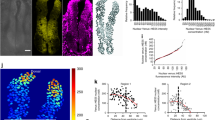Abstract
The Notch signaling effectors Hes1 and Hes7 exhibit oscillatory expression with a period of about 2–3 h during embryogenesis. Hes1 oscillation is important for proliferation and differentiation of neural stem cells, whereas Hes7 oscillation regulates periodic formation of somites. Continuous expression of Hes1 and Hes7 inhibits these developmental processes. Thus, expression dynamics are very important for gene functions, but it is difficult to distinguish between oscillatory and persistent expression by conventional methods such as in situ hybridization and immunostaining. Here, we describe time-lapse imaging methods using destabilized luciferase reporters and a highly sensitive cooled charge-coupled device camera, which can monitor dynamic gene expression. Furthermore, the expression of two genes can be examined simultaneously by a dual reporter system using two-color luciferase reporters. Time-lapse imaging analyses reveal how dynamically gene expression changes in many biological events.
Access this chapter
Tax calculation will be finalised at checkout
Purchases are for personal use only
Similar content being viewed by others
References
Hirata H, Yoshiura S, Ohtsuka T et al (2002) Oscillatory expression of the bHLH factor Hes1 regulated by a negative feedback loop. Science 298:840–843
Masamizu Y, Ohtsuka T, Takashima Y et al (2006) Real-time imaging of the somite segmentation clock: revelation of unstable oscillators in the individual presomitic mesoderm cells. Proc Natl Acad Sci U S A 103:1313–1318
Shimojo H, Ohtsuka T, Kageyama R (2008) Oscillations in Notch signaling regulate maintenance of neural progenitors. Neuron 58:52–64
Kobayashi T, Mizuno H, Imayoshi I et al (2009) The cyclic gene Hes1 contributes to diverse differentiation responses of embryonic stem cells. Genes Dev 23:1870–1875
Jarriault S, Brou C, Logeat F et al (1995) Signalling downstream of activated mammalian Notch. Nature 377:355–358
Takebayashi K, Sasai Y, Sakai Y et al (1994) Structure, chromosomal locus, and promoter analysis of the gene encoding the mouse helix-loop-helix factor HES-1. Negative autoregulation through the multiple N box elements. J Biol Chem 269:5150–5156
Baek JH, Hatakeyama J, Sakamoto S et al (2006) Persistent and high levels of Hes1 expression regulate boundary formation in the developing central nervous system. Development 133:2467–2476
Bessho Y, Sakata R, Komatsu S et al (2001) Dynamic expression and essential functions of Hes7 in somite segmentation. Genes Dev 15:2642–2647
Hirata H, Bessho Y, Kokubu H et al (2004) Instability of Hes7 protein is critical for the somite segmentation clock. Nat Genet 36:750–754
Takashima Y, Ohtsuka T, Gonzaléz A et al (2011) Intronic delay is essential for oscillatory expression in the segmentation clock. Proc Natl Acad Sci U S A 108:3300–3305
Niwa Y, Shimojo H, Isomura A et al (2011) Different types of oscillations in Notch and Fgf signaling regulate the spatiotemporal periodicity of somitogenesis. Genes Dev 25:1115–1120
Harima Y, Takashima Y, Ueda Y et al (2013) Accelerating the tempo of the segmentation clock by reducing the number of introns in the Hes7 gene. Cell Rep 3:1–7
Luker GD, Pica CM, Song J et al (2003) Imaging 26S proteasome activity and inhibition in living mice. Nat Med 9:969–973
Qian X, Goderie SK, Shen Q et al (1998) Intrinsic programs of patterned cell lineages in isolated vertebrate CNS ventricular zone cells. Development 125:3143–3152
Miyata T, Kawaguchi A, Okano H et al (2001) Asymmetric inheritance of radial glial fibers by cortical neurons. Neuron 31:727–741
Acknowledgements
This work was supported by Core Research for Evolutional Science and Technology and Grant-in-Aid for Scientific Research on Innovative Areas (MEXT 22123002).
Author information
Authors and Affiliations
Corresponding author
Editor information
Editors and Affiliations
Rights and permissions
Copyright information
© 2014 Springer Science+Business Media New York
About this protocol
Cite this protocol
Shimojo, H., Harima, Y., Kageyama, R. (2014). Visualization of Notch Signaling Oscillation in Cells and Tissues. In: Bellen, H., Yamamoto, S. (eds) Notch Signaling. Methods in Molecular Biology, vol 1187. Humana Press, New York, NY. https://doi.org/10.1007/978-1-4939-1139-4_13
Download citation
DOI: https://doi.org/10.1007/978-1-4939-1139-4_13
Published:
Publisher Name: Humana Press, New York, NY
Print ISBN: 978-1-4939-1138-7
Online ISBN: 978-1-4939-1139-4
eBook Packages: Springer Protocols




